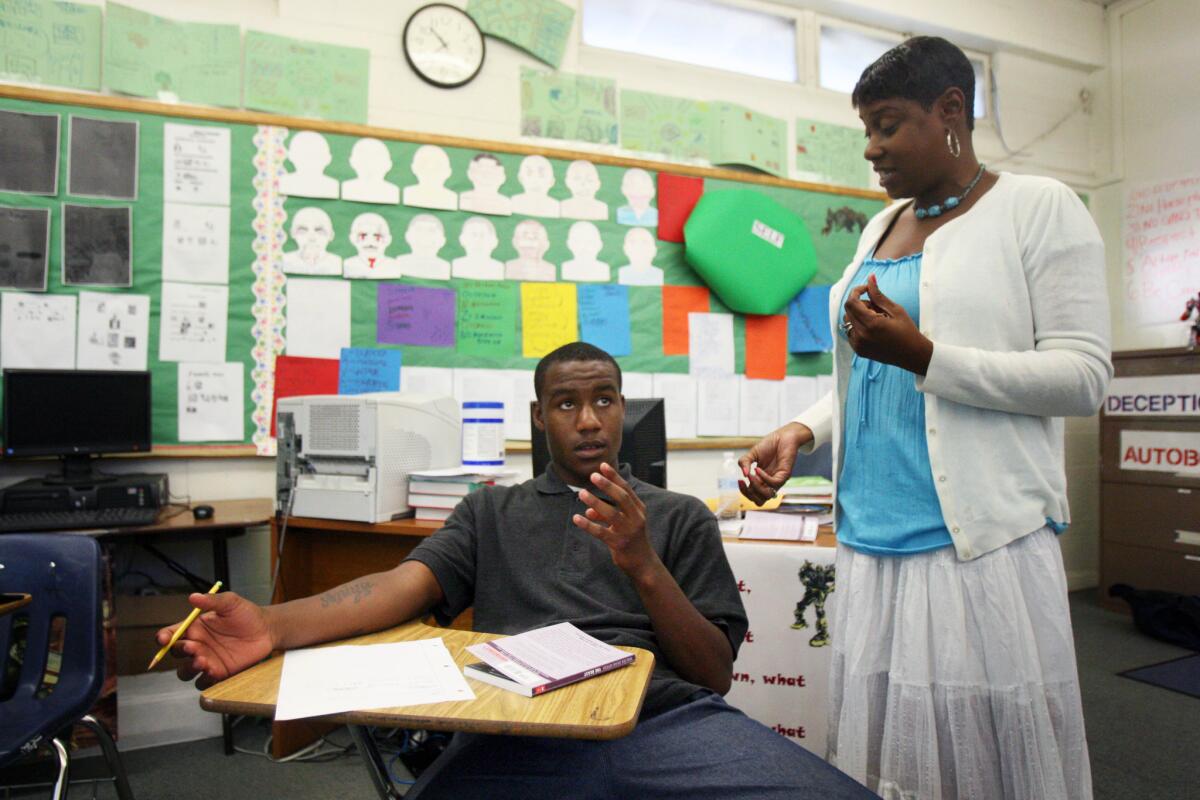California fails to adequately educate youth inmates, report says

- Share via
California and other states are largely failing to adequately educate most of the 70,000 youth locked up at any given time in juvenile detention facilities, according to a national report released Thursday.
Most youth fail to earn any course credits or complete their high school diploma or equivalency degree while in custody, the report by the Southern Education Foundation found. Yet these young inmates are highly troubled – usually struggling with drug abuse, anger and lagging academic achievement – and urgently need effective education to help them get back on track, the report said.
“It’s the classic sad story of the children with the greatest needs getting the least assistance to turn around their lives,” said Steve Suitts, the foundation’s vice president and study’s author.
The report cited studies showing that juveniles who made above-average academic gains while incarcerated were far more likely to return to school and avoid rearrest after release. In turn, taxpayers would save millions of dollars. In L.A. County, for instance, the average monthly cost to house a youth in a probation camp is about $10,000.
Southern states had the worst record of educating their juvenile offenders, the report found. Only 36% of eligible youth earned high school credits while incarcerated in 15 southern states, compared to 44% in the Midwest, 53% in western states and 55% in the Northeast. California’s rate was 58%.
Only about 8% of eligible students nationally and 5% in California earned their high school diplomas or equivalency credential.
The report examined federal and state data from 2006 through 2011, along with a variety of studies on education in the juvenile justice system. Suitts acknowledged the picture could have improved since then in some places but that overall not much has changed.
“There is no question that these systems are broken and education is not being delivered in an effective way,” Suitts said.
In Los Angeles County, however, federal investigations and a class-action lawsuit in the last decade have pushed officials to make significant reforms in improving conditions for 1,675 juveniles in its 16 probation halls and camps.
The system has shifted its focus from incarcerating youth to placing most minor offenders in community programs, resulting in a 46% decline in the camp population since 2006. Officials learned that locking up minor offenders with more serious ones did nothing to improve them, said Don Meyer, assistant chief probation officer.
“California has gotten the message that we probably locked up too many kids for too long and that has dramatically changed,” he said.
The Los Angeles County Office of Education, charged with educating juveniles in detention facilities, has also made significant changes following a 2010 class-action lawsuit alleging inadequate school and rehabilitative services.
The improvements included an expansion of career and technical training opportunities, classes to recover high school credits, an award-winning “Road to Success” initiative of project-based learning and new reading and math programs. The county office also beefed up teacher training and data on student progress.
Since the reforms, students have made gains in reading scores and high school exit exam pass rates. The number of students who earned their diplomas doubled to 137 students from 2010-11 to 2012-13, while those who earned their high school equivalency credential increased to 68% from 61% during the same period.
And “close to 100%” of students earn at least one high school course credit, said Cuauhtemoc Avila, the county education office’s assistant superintendent of educational programs.
“Having all of these programs has made a big difference,” he said. “We strongly believe that education is the best intervention for all kids but especially these, who are the most vulnerable.”
The report called for a national shift in making education the top priority for all juvenile detention systems. Other recommendations including increasing academic standards and curriculum, improving testing and reporting results and creating individualized learning plans for each juvenile.
“We have systems built around the idea that their primary purpose is to keep kids in confinement,” Suitts said. “But they have to come to terms with the fact that education should be their first priority because that’s how you correct them.”
Twitter: @TeresaWatanabe
More to Read
Sign up for Essential California
The most important California stories and recommendations in your inbox every morning.
You may occasionally receive promotional content from the Los Angeles Times.











